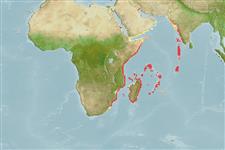Common names from other countries
Environment: milieu / climate zone / depth range / distribution range
Ecologia
marinhas associadas(os) a recifes. Tropical
Western Indian Ocean: Kenya and Mozambique to islands in the western Indian Ocean.
Tamanho / Peso / Idade
Maturity: Lm ? range ? - ? cm
Max length : 21.0 cm SL macho/indeterminado; (Ref. 3503); common length : 20.0 cm TL macho/indeterminado; (Ref. 5450)
Espinhos dorsais (total) : 12; Raios dorsais (total) : 9; Espinhos anais: 3; Raios anais : 5. A black spot nearly as large as eye on inner surface of pectoral fins near base of first 5 rays; no black mark inside mouth at front of upper jaw. Ascending process of premaxilla narrow, its maximum width 1.8-2.2 in orbit diameter; a series of papillae or nodules (sometimes on a low ridge) across interorbital space between supraocular spines; nasal spine single (Ref 42181).
Usually found immobile at the bottom camouflaged among rocks and coral. Hunts by ambushing prey (Ref. 5503). Unlike most scorpaenids, the sting from the dorsal spines of this species can be painful but does not pose any real danger to the victim (Ref. 5503). Sold fresh in small quantities in markets.
Ciclo de vida ou comportamento de acasalamento
Maturities | Reprodução | Spawnings | Egg(s) | Fecundities | Larvas
Randall, J.E and W.N. Eschmeyer, 2001. Revision of the Indo-Pacific scorpionfish genus Scopaenopsis, with descriptions of eight new species. Indo-Pac. Fish. (34):79 p. (Ref. 42181)
Status na Lista Vermelha da UICN (Ref. 130435)
CITES (Ref. 128078)
Not Evaluated
Ameaça para os humanos
Traumatogenic (Ref. 5503)
Uso pelos humanos
Pescarias: pouco comercial
Ferramentas
Relatórios especiais
Baixar XML
Fontes da internet
Estimates based on models
Preferred temperature (Ref.
115969): 25 - 28.9, mean 27.2 (based on 444 cells).
Índice de diversidade filogenética (Ref.
82804): PD
50 = 0.5000 [Uniqueness, from 0.5 = low to 2.0 = high].
Bayesian length-weight: a=0.01259 (0.00606 - 0.02615), b=3.03 (2.86 - 3.20), in cm Total Length, based on LWR estimates for this (Sub)family-body shape (Ref.
93245).
Nível Trófico (Ref.
69278): 4.2 ±0.73 se; based on food items.
Resiliência (Ref.
120179): médio(a), tempo mínimo de duplicação da população 1,4 - 4,4 anos (Preliminary K or Fecundity.).
Fishing Vulnerability (Ref.
59153): Low vulnerability (16 of 100).
